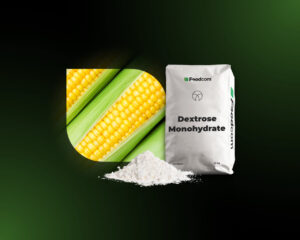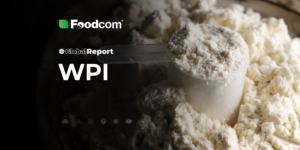- Dextrose monohydrate has gained importance as a natural and functional ingredient in response to the “clean label” trend.
- Global logistical disruptions and rising raw material costs have prompted companies to relocate production and diversify their supply sources.
- Asian and South American markets have gained importance as new centers for dextrose processing and export.
- Regulatory pressure and new tariffs are changing trade patterns and company strategies for 2025.
Dextrose monohydrate, which has been present in the food, pharmaceutical and feed industries for many years, has gained prominence in 2024 as an ingredient that meets market needs: naturalness, functionality and simplicity of formulation. Growing interest in clean-label products, changes in the sugar market and cost pressures in processing have given dextrose a broader role – not only as a sweetener, but also as a stabiliser and energy carrier.
At the same time, the sector struggled with rising raw material prices, logistical disruptions and varying regional dynamics. In many countries, demand remained stable, but distribution channels and consumption patterns were changing – particularly in the food and pharmaceutical industries.
Global egg market analysis 2024
Continuing tensions in international trade, volatility in maize prices and changing sanitary and nutritional regulations have forced adjustments on both the production and distribution sides of dextrose monohydrate. As a result, the global value chain has begun to reorganise – towards greater localisation of production and diversification of export destinations.
According to Fact.MR estimates, the value of the global dextrose monohydrate market reached USD 4.91 billion in 2024. It is expected to grow to USD 7.63 billion within a decade, representing a compound annual growth rate (CAGR) of 4.5%. However, this growth potential is based on an increasingly complex backdrop – requiring companies to be flexible, responsive to regulatory changes and resilient to logistical disruptions.
In the first half of the year, the main factor influencing the market situation was more expensive raw materials – particularly in South America and Asia, where adverse climatic conditions took their toll on the maize harvest. This translated into increased processing costs and, consequently, dextrose prices in many regions. In Central and Eastern Europe, where much of the product is imported, prices have risen by an average of 10-14% compared to the previous year. Some producers have decided to restrict exports or introduce price indexation in contracts.
Against the background of these changes, a new trade map has clearly emerged. Countries such as Mexico, Turkey and Vietnam began to gain importance as sources of alternative production – cheaper, flexible and less dependent on the export policies of the major players. Large food and pharmaceutical companies responded by shifting part of their orders to new locations, building more distributed and more resilient supply chains.
From an applications perspective, 2024 was a year of stable demand, but with a clear shift towards higher value-added products. In the food industry, dextrose grew in importance as an ingredient in functional foods, protein snacks and on-the-go products. In pharma, the segment of liquid infusion preparations and products for malnourished patients grew – especially in Asian countries, where the need for fast energy sources was increasing in the healthcare system.
Regional analysis of the egg market (2024 – Q1 2025)
Although the changes in the dextrose monohydrate market were global, their course and intensity varied by region. Key markets – both production and consumer – adopted different strategies in response to changing trading conditions, raw material availability and local regulations.
Asia: China and India
China maintained its position as the leader in global dextrose monohydrate production, accounting for a significant proportion of exports to developing countries and Europe. Despite trade tensions with the US and Europe, Chinese plants have increased capacity, supported by local subsidies and low processing costs. Environmental constraints remain a key challenge, forcing some producers to upgrade lines for energy efficiency.
India, hitherto mainly a consumer market, has begun to expand exports – particularly towards the Middle East and North Africa – in 2024. The growing pharmaceutical sector, the needs of the healthcare system and the growth of the functional beverage industry have boosted domestic demand, but local producers have also started to compete on price in third markets.
America: USA, Mexico, Brazil
In the US, dextrose remains an important ingredient in the food and pharmaceutical industries, but some producers have reduced exports, focusing on the domestic market. Short-lived shortages of availability in 2024 were reported in the hospital sector, mainly due to logistical tensions and the concentration of production in several states.
At the same time, Mexico and Brazil gained importance as alternative production sources. Both countries invested in modern maize processing plants and attracted customers from Europe and Asia. Mexico particularly developed the dextrose powder segment for food applications, while Brazil focused on animal feed mixtures and the feed sector.
Europe and the Middle East
In the European Union, demand for dextrose was stable, but regulatory restrictions (including limits on simple sugars in children’s products) and high import levels put pressure on local processors. Germany, Poland and the Netherlands are among the main customers, but many companies have started to diversify their supply – importing the product from Turkey and Brazil, among others.
Turkey, in turn, has taken advantage of its geographical position by increasing exports to the EU, North Africa and Central Asia. Its relatively low labour costs and access to regional raw materials make it an increasingly attractive player in the supply chain.
2025 egg market trends and forecasts
The year 2025 opens a new chapter for the global monohydrate dextrose market – increasingly shaped by a changing regulatory environment, trade policy and consumer pressure for compositional transparency. While demand for the product remains stable, it is regulatory and geopolitical issues that are now the main drivers of industry direction.
An increasing number of countries are implementing or announcing regulations to limit the content of simple sugars in food products – especially those aimed at children and young people. Regulations requiring clear labelling of high-sugar products and limiting their presence in public spaces (e.g. schools) are coming into force in Canada, South Korea and parts of the European Union. Although dextrose, as a natural ingredient, is not directly banned, food companies are increasingly choosing to limit its use or move it into the functional food segment.
In addition, the US-Chinatrade conflict has deepened . The resumption of tariffs on selected agricultural and processed products announced by the Trump administration also extended to categories relevant to the starch industry. For the dextrose market, this means potential disruption to raw material trade and increased import costs between the two key economies. Companies operating on Asian-American routes are already feeling the effects of the slowdown – both in logistics and in final contract prices.
“The new tariffs imposed by the US are directly affecting the calculations of many companies using dextrose – especially in the food and pharmaceutical industries. It is not only a question of higher costs, but also of greater uncertainty in planning purchases and long-term contracts. For manufacturers that have relied heavily on supplies from Asia, 2025 may mean they have to quickly reorganise their logistics and look for closer, more predictable sources of supply.” – Lukasz Klazynski.
In response to the new challenges, many companies in 2025 are focusing on:
- localising production and shortening supply chains,
- diversifying markets and sources of raw materials (e.g. the rise of South America and Turkey),
- the adaptation of product formulations to upcoming nutritional standards.
While the industry continues to rely on strong demand from the food and pharmaceutical sectors, operational flexibility, compliance with local regulations and the ability to manage commercial risk in an increasingly unpredictable environment will be key to the future of the market.
Global Foodcom S.A. reports.
Curious about what’s next for dextrose monohydrate? Discover the latest trends and insights that will shape the final months of 2025. Visit our blog as we regularly update our global reports. Stay up to date with Foodcom S.A.
![Overview and analysis of the dextrose monohydrate market in 2026 [Global Report] Overview and analysis of the dextrose monohydrate market in 2026 [Global Report]](https://foodcom.pl/wp-content/uploads/2025/04/Global-Report-szablon-pod-bloga1-1520x760.png)


![Przegląd i analiza rynku jajek w 2025 [Global Report] Przegląd i analiza rynku jajek w 2025 [Global Report]](https://foodcom.pl/wp-content/uploads/2025/04/Global-Report-szablon-pod-bloga-egg-na-bloga-300x150.png)
![Przegląd rynku mozzarelli w 2025 [Global Report] Przegląd rynku mozzarelli w 2025 [Global Report]](https://foodcom.pl/wp-content/uploads/2025/03/Przeglad-rynku-mozzarelli-w-2025-Global-Report-300x150.png)



